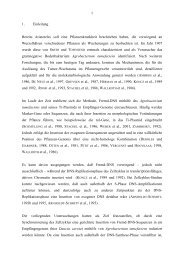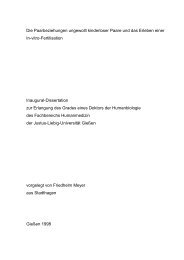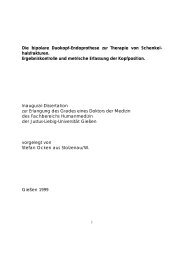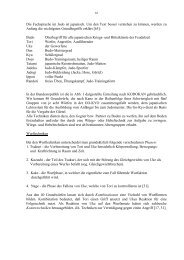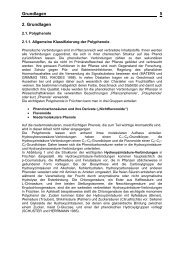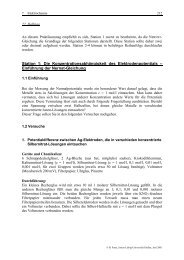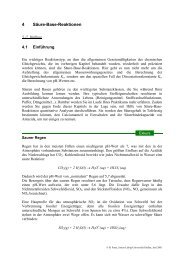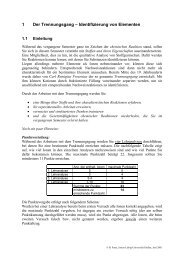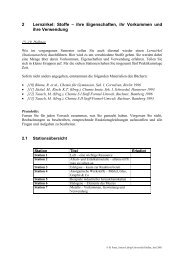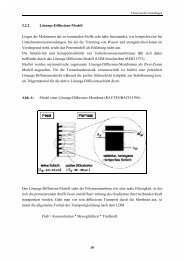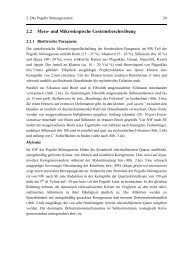Effects of diabaticity on fusion of heavy nuclei in the dinuclear model ...
Effects of diabaticity on fusion of heavy nuclei in the dinuclear model ...
Effects of diabaticity on fusion of heavy nuclei in the dinuclear model ...
You also want an ePaper? Increase the reach of your titles
YUMPU automatically turns print PDFs into web optimized ePapers that Google loves.
Chapter 2<br />
The study <str<strong>on</strong>g>of</str<strong>on</strong>g> nucleus-nucleus collisi<strong>on</strong>s at energies <str<strong>on</strong>g>of</str<strong>on</strong>g> some few MeV/u above <strong>the</strong> <strong>in</strong>teracti<strong>on</strong><br />
barrier stimulated <strong>the</strong> development <str<strong>on</strong>g>of</str<strong>on</strong>g> <strong>the</strong>oretical c<strong>on</strong>cepts for large-amplitude collective nuclear<br />
moti<strong>on</strong> [44]. We note <strong>in</strong> particular <strong>the</strong> <strong>in</strong>troducti<strong>on</strong> <str<strong>on</strong>g>of</str<strong>on</strong>g> transport <strong>the</strong>ories like <strong>the</strong> random-<br />
matrix approach [45], <strong>the</strong> <strong>on</strong>e-body dissipati<strong>on</strong> <strong>model</strong> [46, 47] and <strong>the</strong> l<strong>in</strong>ear resp<strong>on</strong>se <strong>the</strong>ory<br />
[48]. These <strong>the</strong>ories assume (ei<strong>the</strong>r explicitly or implicitly) a statistical equilibrium with<strong>in</strong> <strong>the</strong><br />
<strong>in</strong>tr<strong>in</strong>sic degrees <str<strong>on</strong>g>of</str<strong>on</strong>g> freedom throughout <strong>the</strong> collisi<strong>on</strong> described by a few collective variables.<br />
Such a local equilibrium, however, is not expected to be realistic dur<strong>in</strong>g <strong>the</strong> <strong>in</strong>itial stage <str<strong>on</strong>g>of</str<strong>on</strong>g><br />
a nucleus-nucleus collisi<strong>on</strong>, a process which starts from <strong>the</strong> approach <str<strong>on</strong>g>of</str<strong>on</strong>g> two <strong>nuclei</strong> <strong>in</strong> <strong>the</strong>ir<br />
ground states. Because <str<strong>on</strong>g>of</str<strong>on</strong>g> <strong>the</strong> l<strong>on</strong>g mean free path, <strong>the</strong> moti<strong>on</strong> <str<strong>on</strong>g>of</str<strong>on</strong>g> <strong>the</strong> <strong>in</strong>dividual nucle<strong>on</strong>s dur<strong>in</strong>g<br />
<strong>the</strong> approach phase is governed by <strong>the</strong>ir self-c<strong>on</strong>sistent mean potential which evolves <strong>in</strong> time.<br />
Therefore, this stage should be well described by <strong>the</strong> time-dependent Hartree-Fock (TDHF)<br />
<strong>the</strong>ory [49]. <str<strong>on</strong>g>Effects</str<strong>on</strong>g> from residual two-body collisi<strong>on</strong>s and <strong>the</strong> corresp<strong>on</strong>d<strong>in</strong>g transiti<strong>on</strong> to local<br />
equilibrium were formulated <strong>in</strong> extensi<strong>on</strong>s <str<strong>on</strong>g>of</str<strong>on</strong>g> TDHF [50]. An alternative <strong>model</strong> was <strong>in</strong>troduced<br />
<strong>in</strong> [51] by <strong>the</strong> c<strong>on</strong>cept <str<strong>on</strong>g>of</str<strong>on</strong>g> dissipative diabatic dynamics (DDD) as a time-dependent shell-<strong>model</strong><br />
approach. This <strong>model</strong> takes <strong>in</strong>to account simultaneously <strong>the</strong> coherent and <strong>in</strong>coherent forms <str<strong>on</strong>g>of</str<strong>on</strong>g><br />
moti<strong>on</strong> <str<strong>on</strong>g>of</str<strong>on</strong>g> <strong>the</strong> nucle<strong>on</strong>s <strong>in</strong> nucleus-nucleus collisi<strong>on</strong>s. For sufficiently large collective velocities<br />
(typically <strong>the</strong> collective k<strong>in</strong>etic energy per nucle<strong>on</strong> needs to be larger than 0.03 MeV) <strong>the</strong><br />
nucle<strong>on</strong>s no l<strong>on</strong>ger adjust <strong>the</strong>ir wave functi<strong>on</strong>s adiabatically but diabatically, <strong>the</strong>reby preserv<strong>in</strong>g<br />
<strong>the</strong> nodal structure (character) <str<strong>on</strong>g>of</str<strong>on</strong>g> <strong>the</strong> wave functi<strong>on</strong>s. Adiabatic basis states are not always<br />
useful [52]. It was realized by Landau, Stueckelberg and Zener [53] that it is advantageous at<br />
17



